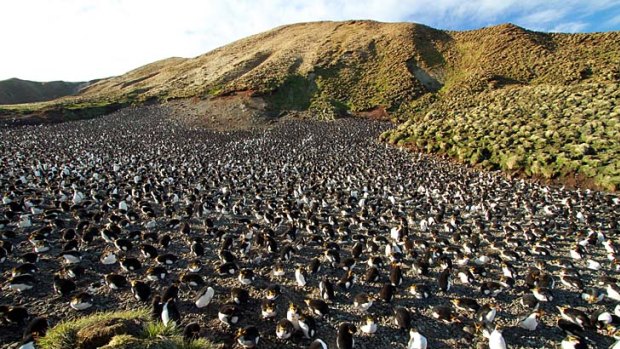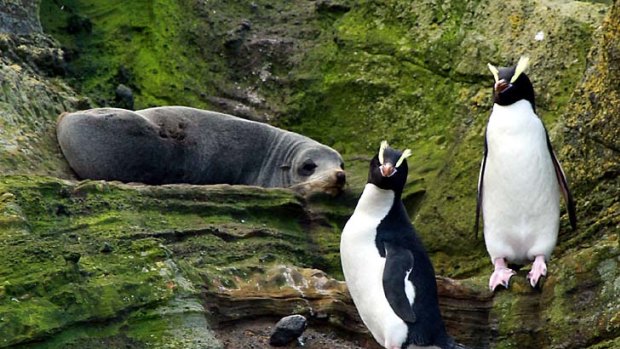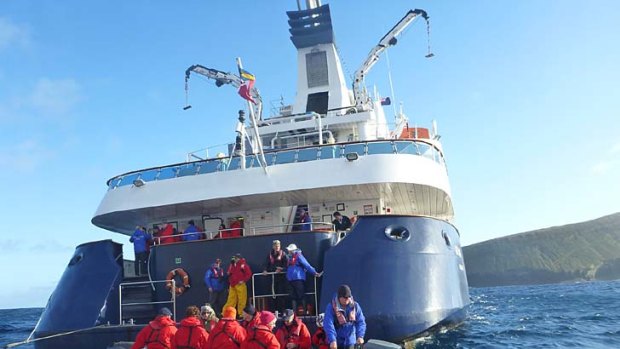
Rare and remote ... a rookery of royal penguins on Macquarie Island.Credit: Orion
John Huxley joins a shipload of experts, enthusiasts and 'penguin people' on a mission in the Sub-Antarctic Islands.
Their 15-day expedition to the Sub-Antarctic Islands has not even begun but, as they wait to board the ship in Auckland, Mike and Jo Cox are already twitching with excitement and, they admit, edginess.
"We're really looking forward to it," Mike says. "We've waited a long time. But ... well, we're just keeping our fingers crossed." For good reason.

A pair of erect-crested penguins and a fur seal on the Antipodes Islands.Credit: Orion
Some people collect stamps. Some snow domes. Some vintage cars. The Coxes "collect" penguins. Long-time birdwatchers, they began specialising several years ago. "We thought it would be fun to have a target." A quest.
Many adventures, many trips round the world, many tens of thousands of dollars later, they have seen 16 of the 17 penguin species: king, emperor, royal, chinstrap, little blue and so on.
Now they have travelled from their home in Scotland to the other end of the Earth hoping to see the final one: the erect-crested penguin, which breeds only on the remote Bounty and Antipodes islands, on the way to the South Pole.

"Ship of many eyes" ... the "penguin people" set out in a Zodiac from the MV Orion.
"We travel hopefully," says Mike, who cheerfully admits that when he retired recently from his university job, every farewell card and present celebrated his glorious obsession with penguins.
Remarkably, it turns out, the Coxes are not the only pair of "penguin people" on board the MV Orion. Clinton and Missy, of Boston, and Ken and Mairi, of Nelson, New Zealand, are also hanging out for an erect-crested.
They will have a nervous wait until day five, when the Orion is scheduled to reach the Bounty Islands, described in the ship's daily diary as "a bare windswept group of slippery granite rocks with no safe anchorage or easy landing sites".
Thankfully, before and beyond that, there is much to see, do and enjoy on a trip that - as the Orion's description as an "expedition cruise ship" suggests - combines a sense of purpose and discovery with fine wining, dining and living.
The Orion is a smaller, more stylish, more intimate ship than some of the floating, skyscraping cities lined up alongside it in Auckland. Significantly, crew members outnumber guests, 79:71. The crew includes a dozen authors, environmentalists, birders and enthusiasts - all experts on subjects from Maori culture to local mega-herbs, shipwrecks to elephant seals, geology to bar-tailed godwits.
Twice daily they offer lively lectures aimed at enhancing the expedition; they expertly load us on and off the high-speed Zodiacs used to access the islands; and lead expeditions through some of the world's most fragile environments.
The passengers, who include research scientists being ferried in luxury to or from their austere accommodation on the islands, range in age from mid-30s to mid-80s. Typically, they are authors, academics and business people, many of them retired, drawn from about a dozen nations. They are active, adventurous, gifted, generous, convivial and passionate about the environment. And the penguins.
Many have come for the birds, if not specifically for the penguins. According to a World Wildlife Fund Australia program manager based in Broome and onboard guide, Alex Watson, the trip takes us into the best place for sea birds in the world.
"Different latitudes, different seas, different birds," he says, as the Orion, equipped with stabilisers, prepares to sail south through the infamous Roaring Forties and into the Furious Fifties. Into sea-bird central.
Count me among the twitchers. Not least of the attractions on this trip is the once-in-a-lifetime chance to increase substantially my count of birds seen in Australia.
Due largely to a dearth of sea-spottings, despite occasional palaegic bird trips from Sydney, my list numbers only 446. To put that into perspective, the Australian list leader, Victorian Mike Carter, has ticked 828.
A fellow Broome-based guide, Adrian Boyle, 15th on the same list, is confident of adding others. "We're a ship of many eyes. We can't miss," he says, as birders assemble on the aft-deck, binoculars at the ready, even before the Orion sets sail.
Apart from occasional excursions up forward when the waves are not crashing over the bow, we will assemble aft, looking across the wash, at daybreak and dusk - and many happy hours in between - for the next 15 days.
For those obsessive enough to count and keep lists, issues arise. First, there's the vexed question of taxonomy: when does a bird, from a specific Sub-Antarctic island, say, become sufficiently different to be recognised as a species?
Experts and, therefore, lists do not agree; not even about the penguins, whose species number between 16 and 20, depending on whose book is used. We agree on a convention.
Then, how will we know when a bird qualifies for the Australian list? The highlight of the trip might be the day spent on Australia's Macquarie Island but for most of the voyage the Orion will be in New Zealand or international waters. The crew on the bridge are asked to provide alerts.
And, finally, how can a far-distant bird, spotted briefly wheeling through the waves, in poor weather, from a heaving deck, often by heaving spotters, be conclusively identified?
A bird-migration expert, Nigel Milius, insists that some species, such as the fairy and fulmar prion, I think, are so alike they can't be differentiated even when held in the hands, let alone when glimpsed half a kilometre away.
Fortunately, the birding party has at its disposal not just many eyes but the best guide books, the world's best guides (including American tour leaders Victor Emanuel and Barry Lyon) and the best long lenses available.
In such things, size and shutter speed matter. As Watson says enviously of Boyle's camera: "It's so powerful you can actually see what the bird is thinking." Certainly, it captures the fine detail needed to nail a species.
Within hours, four different albatrosses, five petrels and three shearwaters head a new trip list. The only minor regret, for those obsessive enough to care, is that they were not seen in Australia, and the flying fish don't count.
As darkness falls and a lone Kiwi trawler, the only vessel we shall see on a round trip of several thousand kilometres, disappears into the distance, the adventurers slip comfortably into a routine.
Some days are spent entirely, enjoyably, at sea, going places. Big breakfasts. Fascinating lectures. Gym sessions. Picture shows. Trivia quizzes. Movies. Dinners, picked from menus devised by chef Serge Dansereau of The Bathers' Pavilion.
More often, the good life is punctuated with great excitement, in respectful, non-invasive exploration of the islands - either on foot ashore or, where landings are not possible, by bouncing Zodiacs along coastline teeming with wildlife, fringed with sinuous kelp.
As the expedition leader, Mick Fogg, explains, flexibility is needed hereabouts in negotiating weather that oscillates between "break open the pina colada, bring out the deckchairs" beaut to, more likely, "batten down the hatches" abominable. So it proves.
If this is day four, these will be the Chatham Islands, population 650, scene of Maori conquest and genocide, of rolling, rural beauty and rare birds, such as the endemic, endangered local pigeon. The walking is bracing, the welcome in the "capital" of Waitangi warm and the weather fine, though as we head back to the Orion, the sea is swelling five or six metres. Safely back on board, the penguin people are thinking things erect and crested.
Overnight on day five, the weather has cut up rough. Sick-bags have been slipped under doors. Some of them have been filled. At 2pm, Fogg delivers the bad news: the Orion has lost five hours battling high seas that have "been hitting us hard on the nose".
Regretfully, a decision has been taken to bypass the Bounty Islands - named after the ship of their European discoverer Captain Bligh, only months before the famous mutiny - and head straight for the Antipodes Islands, a group of volcanic islands littered with shipwrecks and abandoned by humans, after hunting the seals almost to extinction in the 1830s. Commiserations are conveyed to the disappointed penguin people, news of whose quest has spread through the ship. Tomorrow offers the last chance on this trip to complete their set of species.
What will Mike Cox do if the Zodiacs cannot access the Antipodes? "I'll throw myself overboard," he says. Surely, it's not the end of the world? "Well, actually, it is," one of several Canadians on board insists, and helpfully points towards the South Pole.
Miraculously, day six dawns innocent as a dew drop. By 8am, the penguin people, a local author and expert guide Neville Peat and their media agent (me), are loaded into the first Zodiac and bumped across Anchorage Bay to the rocks.
And there they are! Erect-crested penguins. The six penguin people, orchestrated by Jo Cox, swap high fives, stick their thumbs triumphantly in the air and try to balance long enough to take close-up shots.
By mid-afternoon, the weather is so rough that one of the Zodiacs is almost overturned as it's washed into the air and onto the disembarkation deck, before crashing back into the sea.
But the penguin people have seen and photographed enough for one day. Later, their mission will be celebrated in cake form, featuring a pair of embracing erect-crested penguins.
Mission accomplished. But, of course, there is so much more to learn, to see, to feel in this wild seascape. There's Campbell Island, where we land at Perseverance Bay, see the loneliest tree in the world and take a stunning, hilltop boardwalk among (though never too close to) the nesting albatrosses.
There's Enderby, one of the Auckland Islands, where we walk for five hours past scrapping sea lions, wandering penguins and - thanks to Barry Lyon's expertise, perseverance and sharp eyes - we see the rare sub-Antarctic snipe.
And, on day 11, there's the World Heritage-listed Macquarie Island, known affectionately by the 30 or so people based here as "Macca", described by explorer Sir Douglas Mawson as "one of the wonder spots of the world".
So it still is. Just.
Over the centuries the island has been pillaged by sealers, raped by penguin "farmers", who boiled birds alive in "digester" tanks for oil, and overrun by cats, rats, mice and about 150,000 rabbits.
A $24.6 million pest eradication started last year, with intensive aerial baiting of the 34-kilometre-long island using about 300 tonnes of poison, followed by a two-year "search and kill" program to eradicate surviving rabbits. Hunters and dog-handlers are still working on the island but Tasmanian Parks & Wildlife officials report vegetation and bird habitats are already improving.
Today, the island is home to 100,000 seals and 4 million seabirds, including royal, king, gentoo and rockhopper penguins. They make a joyful, deeply moving sight.
"I feel like I'm starring in a David Attenborough documentary," one of the Kiwis says as, almost on cue, the sun disappears and snow briefly sweeps across the island, lightly dusting the sleeping sea lions and the madding penguins.
It's one of many magical moments. Being ambushed by a 100-kilogram Hooker's sea lion on Enderby. Waking in the night to see the Aurora Australis light show. Hearing Emanuel's orgasmic cries of "oh my god, oh my god" on seeing a rare Antarctic petrel. And, yes, sharing the delight of the penguin people.
So many memories, unimaginable, unforgettable, innumerable. Well, almost innumerable. For the record, I saw - or, more often, was shown - about 120 new species of birds. I added 36 to my Australian list. I had the time of my life.
And what of the penguin people? The Scottish couple, Mike and Jo Cox, decide on a new, more modest target: sighting the five species of kiwis. Clinton and Missy will switch their attention to "big cats".
And Ken and Mairi, who always conceded they were "also-rans", will confess they are an emperor penguin short of a full set. So, will they be heading to Antarctica next winter? "Well," Ken says, "I'm working on it."
John Huxley travelled courtesy of Orion Expedition Cruises.
FAST FACTS
Getting there
Orion Expedition Cruises' 12-day Macquarie Island and New Zealand sub-Antarctic wildlife expedition begins and ends in Bluff, New Zealand, and takes in Milford, Dusky and Doubtful sounds, Stewart Island, Snares Island, the Auckland Islands, Campbell Island and Macquarie Island. It departs on December 8. Fares cost from $9120 a person, twin share, and include an experienced expedition team, all meals, 24-hour room service, entertainment, talks and lectures, Zodiac excursions, port and handling charges, government fees and taxes; check the website for special offers. Phone 1300 361 012, see orionexpeditions.com.
Sign up for the Traveller Deals newsletter
Get exclusive travel deals delivered straight to your inbox. Sign up now.